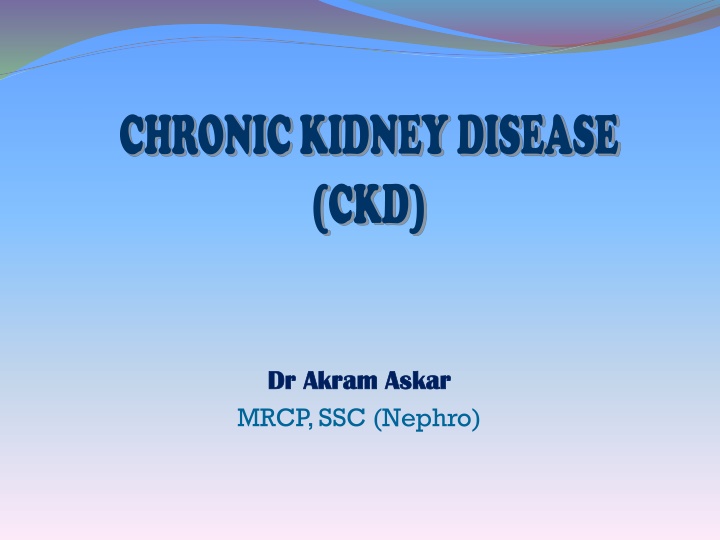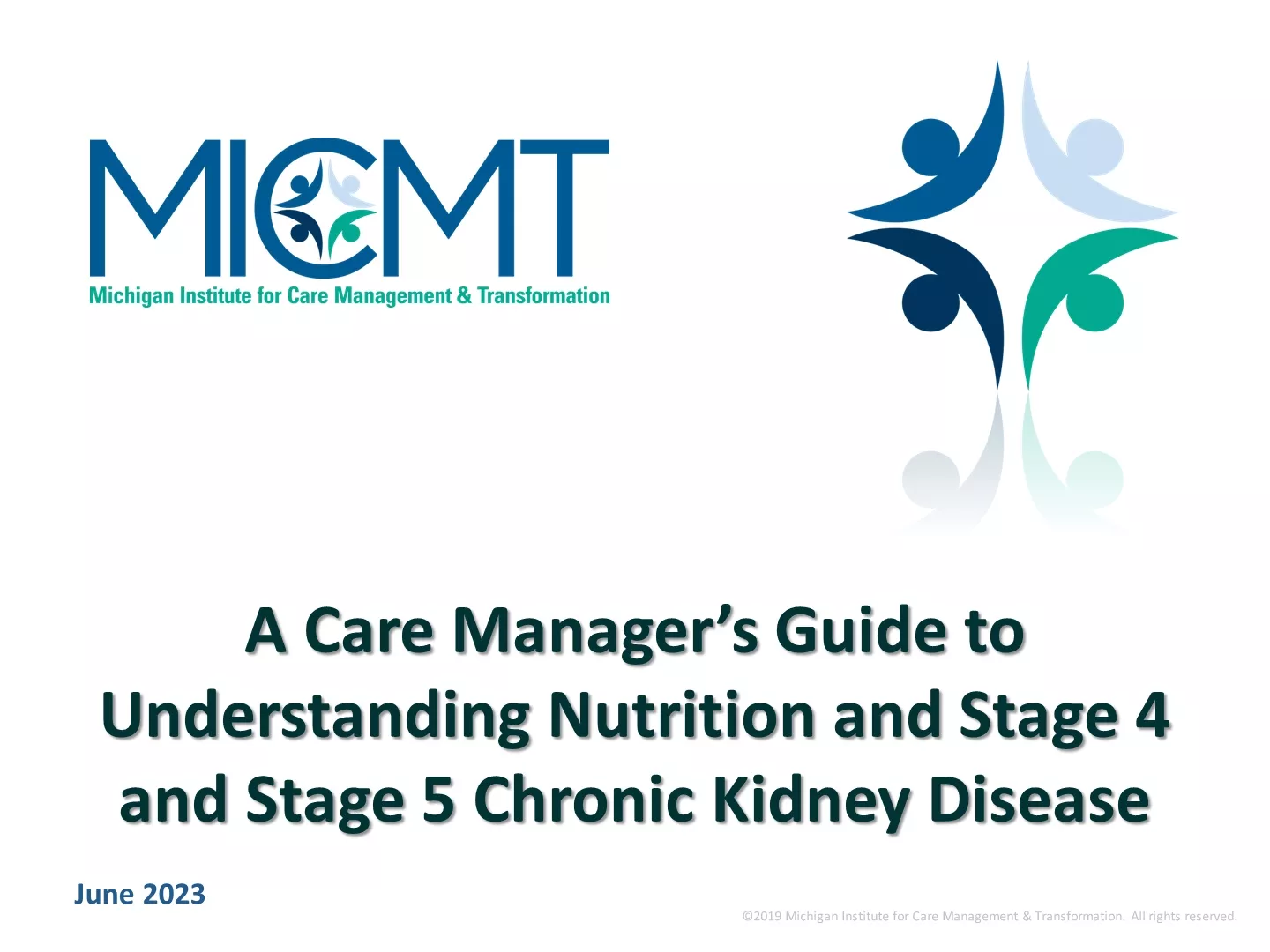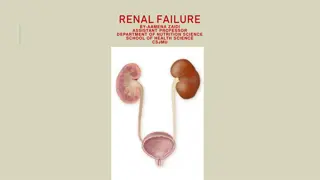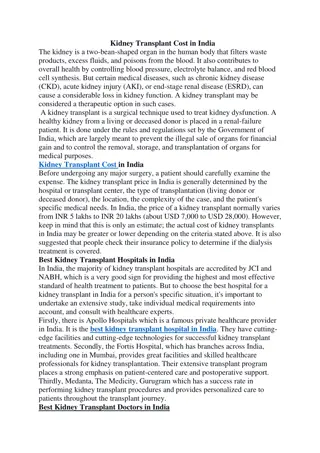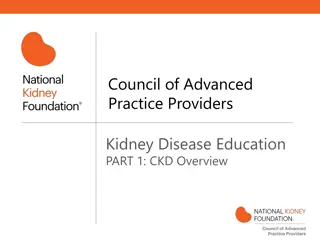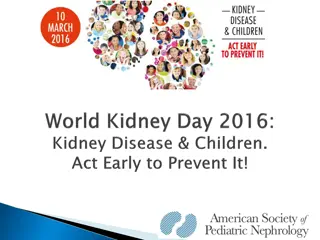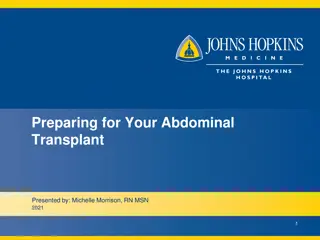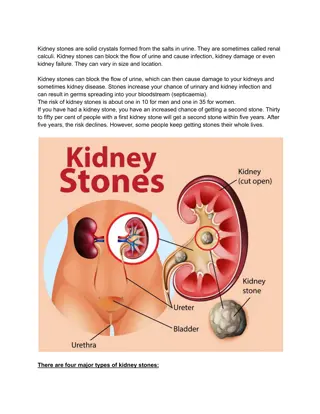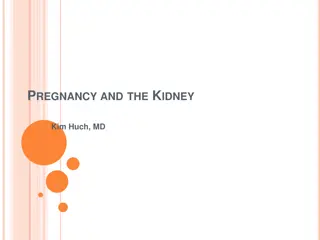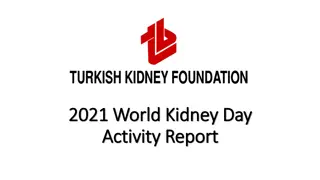CHRONIC KIDNEY DISEASE
Chronic Kidney Disease (CKD) is a progressive condition leading to irreversible loss of renal function. This involves stages categorized by Glomerular Filtration Rate (GFR), ranging from mild kidney damage to kidney failure requiring dialysis or transplant. The pathophysiology of CKD involves loss of nephron mass, hypertrophy of remaining nephrons, and a vicious cycle of progression leading to End-Stage Renal Disease (ESRD). Factors contributing to CKD progression include hypertension, proteinuria severity, hyperlipidemia, drug usage, dietary factors, and extent of tubulointerstitial disease. It is crucial to monitor and manage CKD to prevent complications and preserve kidney function.
Download Presentation

Please find below an Image/Link to download the presentation.
The content on the website is provided AS IS for your information and personal use only. It may not be sold, licensed, or shared on other websites without obtaining consent from the author.If you encounter any issues during the download, it is possible that the publisher has removed the file from their server.
You are allowed to download the files provided on this website for personal or commercial use, subject to the condition that they are used lawfully. All files are the property of their respective owners.
The content on the website is provided AS IS for your information and personal use only. It may not be sold, licensed, or shared on other websites without obtaining consent from the author.
E N D
Presentation Transcript
CHRONIC KIDNEY DISEASE (CKD) Dr Akram Askar Dr Akram Askar MRCP, SSC (Nephro)
Normal Kidney Function Fluid balance Electrolyte regulation Control acid base balance Waste removal Hormonal function Erythropoietin Renin Prostaglandins Active vitamin D3
Bones can break, muscles can atrophy, glands can loaf, even the brain can go to sleep without immediate danger to survival. But should kidneys fail neither bone, muscle, nor brain could carry-on. Hamer Smith, PhD.
CKD (CRF): chronic progressive irreversible loss of renal function ESRD: advanced CKD (Stage-5) requiring dialysis or kidney transplantation
Chronic Kidney Disease - Stages GFR Stage Description (ml/min/1.73m2) 1 Kidney damage with normal or GFR 90 2 Mild GFR 60 89 3 Moderate GFR 30 - 59 4 Severe GFR 15 29 5 Kidney failure, ESRD <15 or dialysis Adapted from Am J Kidney Dis, 2002; 39 (2 Suppl. 1): S46-S75)
Pathophysiology Loss of nephron mass hypertrophy of the remaining nephrons The hypertrophied nephron plasma flow and glomerular pressure increase (vasodilatation of the aff. Arterioles) Proximal reab. of NaCl, Fluids and PO4 Collecting ducts secretion of K+ and H+enhanced These adaptations initially restore hemeostasis But glomerular hyperfiltration glomerular injury, glomerulosclerosis and further loss of renal function.
Pathophysiology Growth factors: Transforming growth factor-B Platelets derived growth factors Interstitial Osteopontin, angiotensin-II fibrosis Endothelin
Viscious cycle of CKD that leads to ESRD Kidney disease | Nephron loss Hypertrophy of Glomerulosclerosis Remaining nephrons BP IG Pressure Filtration ( SNGFR)
Factors contributing to the Progression of CKD Degree of hypertension Severity of proteinuria Hyperlipidemia Drugs (NSAID) High protein diet Persistent metabolic acidosis Extent of tubulointerstitial disease
Etiology of CKD Diabetes mellitus (DM) Hypertension Glomerulonephritis Hereditary cystic and cong. renal disease Interstitial nephritis/pyelonephritis Tumours Miscellaneous 40% 30% 15% 4% 4% 2% 5%
Uremic syndrome Uremia results from retention of end products of protein metabolism * Administration of urea causes only mild symptoms * Other potential uremic toxins: - Guanidine - P2 microglobulin - Hipurate - Homocysteine - Parathyroid hormone (PTH) - Phenoles - Phosphate - Polyamines - Purines -Dimethyl arginine
Metabolic and electrolytes abnormalities in CKD A. Carbohydrate intolerance: Insulin is degraded by the liver and kidneys The decrease in insulin clearance is offset by peripheral insulin resistance Hyperparathyroidism inhibits insulin secretion Decrease in requirements for insulin and OHD in diabetic patients as they develop renal failure. - - - - B. dyslipidemia: HDL cholesterol TG and lipoprotein(a) - -
Metabolic and electrolytes abnormalities in CKD C. Fluid and Electrolytes: * GFR and defective tubular function expansion of plasma and ECF volumes, edema, and hypertension. * Hyponatremia can result from failure to excrete free water when intakes exceed 1.5 L/day *Hypertension is common unless Na+ intake is restricted to 100 meq/day * Patient with salt lossing nephropathy require stepwise increases in Nacl and fluid intake * K+ elimination in CKD is initially maintained by: - enhanced K+ secretion in surviving nephrons - colonic K+ secretion (from aldosterone stimulated by hyperkalemia and metabolic acidosis) However, as GFR decreases, K+ elimination is curtailed hyperkalemia
Metabolic and electrolytes abnormalities in CKD D. Acid-Base abnormalities metabolic acidosis - The body produces about 80 mmol of non-volatile acids from metabolism everyday. - These acids accumulates as renal failure progresses - Production of ammonia NH3 (in distal and CD cells) decreases limits distal tubular H+ trapping as NH4 and hence, decreases renal bicarbonate regeneration. - Additionally, there may be proximal HCO3 wasting or reduced distal H+ secretion.
Calcium and phosphate abnormalities E. GFR < 25 ml / minute Phosphate retention Metabolic acidosis Increase bone resorption Hyperphosphatemia PTH secretion Ionized Ca++ Calcitriol (Hyperparathyroidism) (1, 25[OH], D3) Hypocalcemia Intestinal absorption of calcium
Hyperphosphatemia Independent risk factor in the increased morbidity and mortality of stage-5 CKD from cardiovascular events. Hyperphosphatemia, ca * po4 product (>55 mg/dl), and calcium load (dietary + dialysate) predict coronary artery calcifications (> 50% of stage 5 CKD patients) as evaluated by electron beam computed tomography.
Renal Osteodystrophy (ROD) is a complex disorders of bones in uremic patient resulting from abnormalities of mineral ions (Ca, pon, Mg) ,PTH and Vit-D metabolism in the presence of factors related to the uremic state. Spectrum of bone abnormalities in ROD: 1. Osteitis fibrosa cystica (high bone turnover) due to: a. PTH b. activity of both osteoclast and osteoblast 2. Osteomalacia 3. Adynamic bone disease (low bone tumour) 4. Combination of the above
Renal Osteodystrophy (ROD) Adynamic bone Risk factors: Advanced age CAPD Diabetes mellitus Calcitriol therapy Parathyroidectomy Flouride and iron intoxication Mechanism: Defect in osteoplast development or activity caused by factors related to the uremic state
Cardiovascular abnormalities of ESRD (CKD-5) 1. Hypertension Occurs in 90% of patients with ESRD Causes: * Salt and water retention (the 1omy cause) - - * Inappropriate secretion of RAA system * sympathetic tone * generation of vasoconstrictors (endothelin) * generation of vasodilators (nitric oxide) Cardiomyopathy left ventricular hypertrophy (LVH) Coronary artery disease (CAD) Congestive heart failure (CHF) Diastolic dysfunction 2. - - - -
These abnormalities increase 2-5 folds in ESRD About one-half of all hemodialysis patients have significant ischemic heart disease Dyslipidemia, HTN, homocystin, DM, and insulin resistance contribute to atherosclerosis Anemia aggravates LVH Hyperparathyroidism amyloidosis, and iron overload cause also cardiac dysfunction. Pericarditis and pericardial effusion 3.
Neuromuscular abnormalities CNS dysfunction Decreased attention, agitation, confusion, insomnia, and impaired memory May develop also: depression, hallucinations, delusions, hiccups, cramps, flapping tremor, myocloms, fasciculation, and seizures. Peripheral neuropathy usually symmetric, lower limbs Sensory precedes motor dysfunction Restless leg syndrome and burning feet Postural hypotention (autonomic dysfunction)
Hematologic abnormalities a. Anemia Develops as serum creatinine increases > 180 mcm/L and GFR declines to < 30 ml/minute Nomocystic, nomochrome anemia Main cause: decrease production of EPO b. Platelet Dysfunction Bruising, ecchymoses, bleeding from mm Platelets dysfunction (count is normal): VWF, which facilitate the interaction between platelets and endothelium through its binding to platelet glycoprotein (IIb, IIIa) receptors.
Gastrointestinal abnormalities Anorexia, nausia, and vomiting Uremic faetor, stomatitis, esophagitis, gatritis, and peptic ulcer disease Gastrin in CKD
Dermatologic abnormalities Uremic pruritus is related to: Calcium and phosph deposition (2o PTH) Hypercalcemia Peripheral neuropathy Dry skin Anemia Inadequate dialysis
Evaluation of Patients with CKD The history should document the presence of uremic symptoms and possible etiology from: Diabetes Mellitus, Hypertension, congestive Heart Failure, MM, NSAID Family history can suggest PCKD or hereditary nephritis Volume depletion and obstructive nephropathy should be identified and treated promptly Ultrasound small, shrunken kidneys Normal kidney size with CKD: DM, amyloid, MM
Management of Patients with CKD Fluid and electrolytes disorders: - Salt intake restriction daily Na+ < 100 meq - Loop diuretics - Hyponatremia fluid restriction 1 1.5 L/day - Hyperkalemia: * Exogenous sources of K+ dates, dried fruits, citrus fruits, banana, chocolate, salt substitute * Medications that K+ ACEI, ARB, NSAID, K+- sparing diuretics, B-Blockers, and heparin * Treatment of hyperkalemia - IV calcium gluconate 10 cc of 10% - Followed by 25 ml of 50% dextrose solution with 5-10 units regular insulin - B2-adrenergic agonist nebulizer (salbutamol) - NaHCO3 IV/oral 1.
2. Hyperphosphatemia and secondary hyperparathyroidism: controlled to < 6 mg/dl because it may cause severe soft tissue calcifications - Vitamin D compounds can cause hypercalcemia and hyperphosphatemia, which may increase coronary calcification, so: parcicalcitrol (Zemplar) is an analogue that inhibits PTH synthesis without elevation of calcium/phos. d. Indication for parathyroidectomy: PTH > 800 pg/ml with symptoms of bone disease (myopathy, bone pain) persistent hyperphosphatemia soft tissue calcifications a. Reduce phosphate intake to < 10 mg/kg/day b. Phosphate binders: c. Vitamin D (Calcitriol) 0.125 mcq/day - Must be withheld until s. phosphate concentration have been Calcium carbonate Sevelamer (Renagel) Lanthanum carbonate
3. Hyperlipidemia the goal is to keep low density lipoprotein cholesterol < 100 mg/dl by diet control and statin group. 4. Anemia * Target Hb/Hct: - K DOQI - Anemia: - Conversely: and increased mortality as evidenced by CHOIR (USA) and CREATE (Europe) studies Hb 11-12 Hct 33-36% LVH quality of life reduces survival in patients on HD Hb > 13 Hct > 42 associated with more coronary events
* target iron levels: - percent transferrin saturation (T-SAT) reflects iron available for erythopoiesis - serum ferritin reflects overall iron stores - in CKD, target T-Sat > 20 (20 50) target S. ferritin > 100 ng/ml - iron supp should be withheld, if T-sat > 50 S. ferritin > 800 ng/ml
Treatment Guidelines (Anemia) A. Oral iron - in non-dialysis patients (CKD 1-4): 100-200 mg elemental iron should be given daily in 2-3 days, either one hour before meals or two hours post. (1 tab Ferrous fumerate, 200 mg contains 66 mg elemental iron) - In dialysis patients (CKD 5): IV iron should be given as on-going iron losses tends to be higher B. IV iron - 1 gr of iron saccharate (ferrosac) divided into 10 doses of 100 mg given with each dialysis session.
Treatment GuidelinHDes (Anemia) C. Recombinant Erythropoeitin epoeitin alfa (eprex) - patients on : starting dose 120 180 IU/kg/week, IV - pre-dialysis patients and PD patients: 80-120 IU/kg/week subcutaneously weekly dose - Hb/Hct monitoring every 4 weeks - the most common side effects: headache, HTN, arthralgia, and diarrhea - resistance to epoeitin: 1. inadequate Epo dose 2. anemia of chronic disease (infection, inflammation) 3. functional iron deficiency 4. secondary to hyperparathyroidism 5. carnitine deficiency 6. hemoglobinopathies 7. aluminum toxicity 8. B12/folate deficiency 9. malnutrition
D. Darbepoetin Alfa (Aranesp) than that of epoetin - Recommended starting dose 0.45 mcg/kg S/C weekly or double the dose every 2 weeks. - Recombinant Epo - Half-life: threefold longer IV and twofold longer S/C
